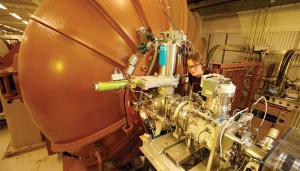LAB REPORT
Science and Technology Making Headlines
Feb. 27, 2015


One giant leap
For three years, software specialist Intelligent Light has been working to bring the open source visualization program VisIt into its family of industrial grade software products. Designed by Lawrence Livermore scientists to visualize data coming off Department of Energy (DOE) supercomputers, VisIt scales well and is well-suited for in situ processing. These features are increasingly important to engineering and manufacturing firms.
Thanks to more than a million dollars in U.S. Small Business Innovation Research (SBIR) grants and the help of computer scientists at Lawrence Livermore, Intelligent Light has made significant progress modifying VisIt for industrial workloads, while it works to merge the government-developed code with its flagship CFD post-processing and visualization suite, FieldView.
FieldView is already used by some of the largest manufacturers, including Boeing, Lockheed Martin, and Toyota, but the company saw areas where FieldView could be improved and made more accessible to smaller companies.


Supermassive black holes at the cores of galaxies blast radiation and ultrafast winds outward, as illustrated in this artist's conception. Image courtesy of NASA/JPL-Caltech
A mighty wind
By looking at the speed of ambient gas spewing out from a well-known quasar, astronomers are gaining insight into how black holes and their host galaxies might have evolved at the same time.
Using the Nuclear Spectroscopic Telescope Array (NuSTAR), researchers were able to use the X-ray spectra of an extremely luminous black hole (quasar PDS 456) to detect a nearly spherical stream of highly ionized gas streaming out of it.
The discovery allowed astronomers to measure, for the first time, the strength of ultrafast black hole winds and show that they are mighty enough to affect the fate of their host galaxies.
"By looking at this huge spherical outflow, we can now see a mechanism to explain the correlation between black hole and galaxy formation," said Bill Craig of Lawrence Livermore and the Space Science Laboratory at University of California, Berkeley.


LLNL biologist Crystal Jaing is one of the developers of the Microbial Detection Array.
Chipping in to virus detection
The Lawrence Livermore Microbial Detection Array can detect, within 24 hours, viruses and bacteria with the use of 388,000 probes that fit on a one-inch wide, three-inch long glass slide.
"All the DNA sequences that it corresponds to, those thousands of viruses and bacteria, are printed in this glass slide,” LLNL biologist Crystal Jaing said. “So, it’s really a lab on the chip."
Jaing is part of the Lawrence Livermore team that developed this breakthrough technology. Jaing says it can be used for many different applications.
"Because this device can analyze any of the sequenced pathogens, we can use in biodefense, public health and drug and food safety."


Ted Ognibene (left), a chemist who has worked on accelerator mass spectrometry for 15 years and who co-developed the technique that accommodates liquid samples, discusses the operation of the instrument with biomedical scientist Mike Malfatti.
From research to practice
Primarily used as a resource for carbon-dating analysis and research, accelerator mass spectrometry (AMS) is now used in forensic analyses, public health (bioAMS) studies, carbon cycle analyses, climate change and geochronology, atmospheric chemistry research, earth system processes, environmental radiochemistry analyses and radioecology/dose assessments.
The greatest advantage AMS has over conventional radiometric methods is the small sample size.
Over the past year, Lawrence Livermore researchers have made dramatic changes to their sample preparation procedures and AMS operations, such that samples can now be processed in just minutes, whereas it took days before. They modified their sample preparation methods to accommodate liquid samples that bypass the time-consuming graphitization process. The Livermore scientists also developed a new and much-simplified biological AMS system that can be operated in almost any routine laboratory use by biomedical researchers without requiring the expertise of accelerator physicists.
The Livermore researchers expect that sometime in 2016, about 90 percent of the samples run in the bioAMS instrument will be liquid samples with the ability to run more than 100 samples/day, according to Graham Bench, the director of the LLNL Center for AMS (CAMS).


Lawrence Livermore National Laboratory Engineer Sat Pannu and his Neural Tech Group research team are developing wireless electronic packages for HAPTIX.
Lending a hand
Lawrence Livermore has joined a collaborative research team that intends to build the world's first neural system to enable naturalistic feeling and movements in prosthetic hands.
Known as Hand Proprioception and Touch Interfaces (HAPTIX), the program seeks to provide wounded service members with dexterous control over advanced prosthetic devices that substitute for amputated hands. If successful, HAPTIX intends to give patients the psychological benefit of having natural sensation in their prosthetic hands and reduction of "phantom limb" pain, a sensation some amputees can feel despite the removal of a limb.
Lawrence Livermore's Neural Tech Group and their collaborators (Case Western Reserve University and the Louis Stokes Cleveland Veteran's Administration Medical Center) intend to develop neural interface systems that measure and decode motor signals recorded in peripheral nerves and muscles in the forearm by using tiny electrodes.





